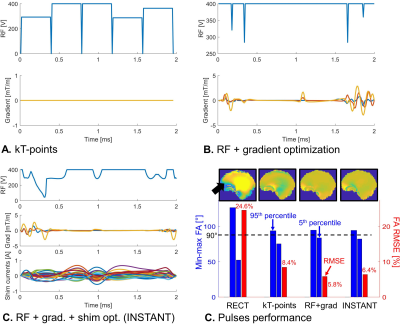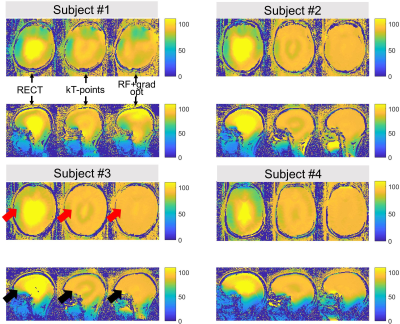Bastien Guerin1, Eugene Milshteyn1, Yulin Chang2, Mads S Vinding3, Mathias Davids1, Wald L Lawrence1, and Jason Stockmann1
1Massachusetts General Hospital, Charlestown, MA, United States, 2Siemens Medical Solutions, Malvern, PA, United States, 3Center for functionally integrative neuroscience, Aarhus, Denmark
1Massachusetts General Hospital, Charlestown, MA, United States, 2Siemens Medical Solutions, Malvern, PA, United States, 3Center for functionally integrative neuroscience, Aarhus, Denmark
Universal kT-point
pulses yield a large improvement in flip-angle uniformity compared to the standard
RECT excitation, even without using pTx. Fully optimized RF + gradient pulses
further improve the pulse performance however adding the shim elements in the
optimization does not.

Fig. 2: 90°, 2ms “universal” excitation pulses and
their performance. For all pulses, the voltage is limited to a maximum of 400V.
A: “Universal” kT-point pulse. B: “Universal” RF + gradient
optimization pulse (no shim currents). C: “universal” RF + gradient +
shim currents pulse (INSTANT). D: RMSE performance of the different
pulse strategies and typical sagittal flip-angle map (first of the three
subjects included in the universal design). The black arrow points to typical
under-flip in the frontal lobe, which is largely corrected by the optimized pulses.

Fig. 3: Flip-angle maps acquired on the last four subjects of the
cohort using a standard rectangular pulse (RECT) and the “universal” kT-point
and RF + gradient optimized pulses shown in Fig. 2. The target flip-angle is a
uniform 90° distribution in the brain (skull has been stripped from the
optimization mask). The red and black arrows point to typical under-flip in the
temporal and frontal lobes, respectively.
